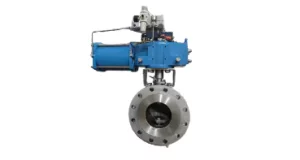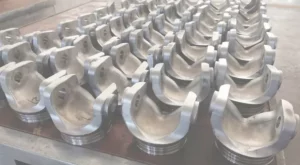Segmented Ball Valve Basics: Key Features and Operational Mechanisms
What is a Segmented Ball Valve?

Definition and Purpose
A segmented ball valve is a valve that has a disc-shaped segment of a V notch on its shoulder. As a result, the flow rate and pressure in different systems can be precisely adjusted. A segmented ball valve is mainly used for flow regulating and has a very low operating torque requirement thus becoming an ideal solution for performing applications where guiding the dynamics of fluid is essential.
Industry Applications
Segmented ball valves are widely used in industries such as petrochemicals, refining, chemicals, pulp and paper, and water treatment. They are vital in processes where fluids need to be regulated over large volumes with precision. Segmented ball valves help it adapt to liquid and gas applications, making it an important feature within the functional sector.
Key Features of Segmented Ball Valves
Design Characteristics
A specific property of these valves is that they are small, making them suitable for installation in a variety of places. This V-shaped sector of the ball provides control of the fluid flow which permits users to achieve high performance at a low flow rate. In addition, the one-piece, leak-proof body design minimizes leakage paths to ensure maximum reliability of these valves.
Material Composition
Mostly segmented ball valves are made of strong materials like stainless steel or other alloys which offer durability as well as leak-proof and corrosion resistance for a long time. The selected materials allow these valves to function properly under high-temperature and pressure conditions. They are built using advanced composite materials, which help them remain tightly sealed yet flexible enough to adapt to environmental changes.
Size and Capacity Variations
The valves are shipped in a range of sizes with DN 80 to DN 300 capacity, therefore suitable for different operational requirements. Segmented ball valves are flexible in terms of applications because they can be designed for size and capacity as per the requirements. They can come fitted with pneumatic to electric actuators, expanding their versatility across different industries.
Operational Mechanisms of Segmented Ball Valves
How It Works
Segmented ball valves control the flow of water through the valve by means of a notch located inside the ball. The ball sector opens the flow passage when turned up and closes it when turned down, by using a valve stem rotation. That means a solid amount of throttle, but also a proper shutoff because you can turn the faucet off when you want to.
Flow Control Mechanism
The differential flow characteristics of segmented ball valves are based on their flow control mechanism around a V-shaped notch. This gives an optimum range of control to the operator, especially at low pressure. Some models offer a self-flushing design that prevents blockages to keep operations running smoothly for the life of the valve.
Pressure Regulation Mechanism
Just like flow control, segmented ball valves also have internal mechanisms that allow for pressure regulation. Able to withstand the fluctuations of pressure whilst not hindering performance. Thanks to this independent packing gland, an effective seal is possible so the valve can still be adjusted and used effectively under changing conditions. Having an independent packing gland enables an effective seal between the valve and the stem to be maintained when operating.
Installation and Maintenance Procedures
Made with specific designs, segmented ball valves are often aligned using flanges or with a threaded connection at the pipeline system. Proper alignment is also essential when installing a valve so it does not cause premature wear or even failure. Installing the valve properly is very important to prevent any premature wear or failure of the valve.
Due to their strong design, not much scheduled maintenance is needed for these valves. Nevertheless, regular inspections are advised to monitor wear in the packing glands and check that the ball is free of obstruction. It is this live-loaded packing system that makes adjustments so simple and effective, adding considerably to the overall valve life cycle.
Advantages of Using Segmented Ball Valves in Industrial Applications
Improved Efficiency
One of the key benefits of broken-flange ball valves is their greater efficiency at controlling fluid flow. The V-shaped notch design provides fine-tuned flow rate modulation, maintaining seamless operations without added energy. Industries thus benefit in terms of lower operational costs while performing at the best quality levels. Additionally, ideal operation torque to control the valve reduces enormously the actuation energy consumption leading to global energy savings as well.
Enhanced Durability and Longevity
The sturdy nature of segmented ball valves makes them long-lasting. Made from durable materials, these valves can endure the demands of numerous commercial applications, such as high pressure and rising temperature. The one-piece design minimizes potential leak paths, providing peace of mind for long-term operation. The reduced need to replace components, which is especially beneficial for operations requiring continuous up-time and reducing maintenance costs as less downtime is required when a few instruments are typically used in an operation, also contributes considerably towards this durability.
Cost-Effectiveness
For a lot of industrial applications, segmented ball valves can offer cost savings. Purchasing solar panels up front, while expensive, is the cheapest solution overall because it pays off in decreased maintenance costs and operational efficiency over time. They deliver performance with utmost reliability, minimizing failures that could cause costly repairs or production stoppages. Moreover, they have a longer service life which leads to fewer replacements and makes them even more cost-effective in industrial environments.
The pledge of quality and innovation guarantees that operators can always depend on Miwival’s products to keep the operations both safe and efficient throughout the operations, therefore improving productivity whilst coming in line with environmental & operational regulations. This promise of quality and innovative solutions means that operators can rely on Miwival products to keep their operations compliant and working safely and efficiently, resulting in increased productivity while also complying with environmental and operational regulations.
Miwival’s Offering: Quality Segmented Ball Valves and Beyond

Overview of Miwival’s Products
Miwival is known for segment ball valve installing the best quality, so the industries can get efficient and reliable service. The most performance-oriented and safest models designed specifically to meet certain operational requirements comprise their product portfolio. Miwival has a collection of extensive types of valves like pneumatic and manual actuated valves with high-quality materials that meet industry standards. This breadth-of-range catalog guarantees that customers are purchasing solutions from a trusted manufacturer for their applications.
Miwival Segmented Ball Valves
Miwival segmented ball valves are designed with accuracy and reliability. The ball sector is constructed in a V-shape, designed specifically to offer high flow control capabilities across a variety of applications including pulp, petrochemical, and water treatment projects. Their production durability is improved with features such as live-loaded packing. Miwival segmented ball valves promise pass-on superior performance with versatility that makes them easy to plug and play with your present systems while remaining compliant with regulatory measures.





